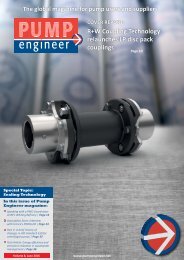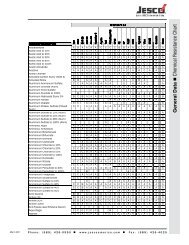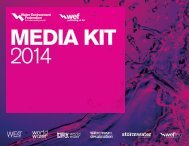KZWja
KZWja
KZWja
- No tags were found...
You also want an ePaper? Increase the reach of your titles
YUMPU automatically turns print PDFs into web optimized ePapers that Google loves.
92PROCEEDINGS OF THE FOURTEENTH TURBOMACHINERY SYMPOSIUMturbine generators (Figure 4). Specific information on theMOD 2 dimensions is listed in Thble 2. Installed costs totaledover 12 million dollars or 4800/kW. Since beginning commercialoperation in November of 1982, the PGandE MOD 2 hasexperienced various problems which have reduced productionto 7000 MWhr, significantly below its theoretical limits [9].Figure 4. PGandE's 2.5 MW MOD 2, Solano County California,1985.Table 2. Information on PGandE's MOD 2 [7].0 Generator Capacity 2500 kW0 Generator Voltage 4160 V/115 kV0 Generator Speed 1800 RPM0 Rotor Length Tip-to-Tip 300 Feet0 Rotor Weight 94 Tons0 Rotor Speed 17.5 RPM0 Tip Speed 190 MPH0 Tower Height 200 Feetlikely limit the commercial development of large multimegawattwind turbines-cost, and the complexity of developmentof designing for a varied wind resource across large rotorareas.Even in mass production, without federal assistance thecosts to install and operate a MOD 2 type machine will not becompetitive with smaller wind machines. For comparativepurposes, the PGandE 2.5 MW MOD 2 cost $4800/kW installedand has produced 7000 MWhr in three years of operation.TERA Power Corporation has operated 50, 50-kWmachines (2. 5 MW) at an installed cost of about $3000/kW foronly two years and has produced 8.5 million kWhrs. Theprincipal reason for this better performance with smallermachines is availability. As will be discussed later, smallmachines have had a large number of problems, perhaps morethan PGandE's MOD 2. However, the number of machinesdeployed per megawatt improves availability and thus production.For example, each problem on the MOD 2 takes 2. 5 MWoffline. Similar problems on a smaller machine take only 0.05MW offline.The second issue of the effects of a site's vertical windresource on large blades poses tremendous uncertainty. Asmore data are collected, shifts in wind directions and speed atvarying heights are showing that many wind sites may belimited to machines that remain within the first 200 feet abovethe ground surface. Because of these issues, multi-megawatttechnology does not appear ready for commercialization. Smallmachine technology does appear to show promise.Small MachinesStarting in 1973, federally funded research on smallmachines took place mainly at the DOE Sandia Laboratories inAlbuquerque, New Mexico, and at DOE's Rocky Flats facility.Vertical Axis Machines. Sandia focused principally onvertical axis technology. Vertical axis machines represent animportant airfoil distinction because each blade section experiencesa constant angle of attack during one rotation, whereas inhorizontal axis machines, each section of blade experiences avaried angle of attack during one rotation [10]. With all majorcomponents on the ground (Figure 5), vertical axis machines0 Nacelle Weight 94 Tons0 Total Weight of WTG 314 Tons (Approx.)0 Cut-In Speed 14MPH0 Cut-Out Speed 60 MPH0 Electronic Controls MicroprocessorThis low output and capacity factor (16 percent in 1984)are attributed primarily to various unforeseen problems withthe machine that have occurred over the last two years. Theseinclude:• The need to install small metallic strips as vortex generatorsto improve the aerodynamic efficiency of the blades• Work on the variable pitch control system• Blade stress situations that were related to differing windspeeds and directions at various levels across the blade• Replacement of a cracked, low-speed shaft• Overheating of the main shaft bearing caused by poorstartup lubricationEven though these problems were serious, they havebeen solved and 1985 performance has improved significantlyover 1984. Ironically, while the PGandE machine has contributedvaluable research information, two factors, which haveindirectly come from its development and operation, will mostFigure 5. Typical Vertical Axis Machine.






